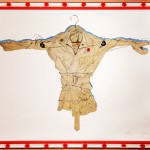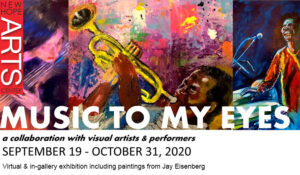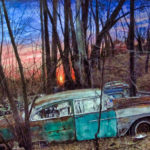 [br] [br] “Heroes”, oil on canvas, self made frame with applied Veteran’s Silk flowers , 56″h x 68″w
[br] [br] “Heroes”, oil on canvas, self made frame with applied Veteran’s Silk flowers , 56″h x 68″w
In its most simplistic terms “Where have all the soldiers gone?”
[br] Once this series of fashion related icons developed it didn’t long before I took my old hippie jacket, a WWII, Army, summer weight jacket, and crucified it with barbed wire, creating a hanger as a crown of thorns and hung it kimono style on a bamboo pole . It was the one I wore in art school to student rallies and anti war demonstrations, some in Washingtion D.C., where I stood facing young soldiers my age, holding rifles and facing me wearing very similar uniforms.
[br] Inspired by my love Gothic Germanic painting and the Isenheim Altarpiece by Gruenwald in particular, representing the gaunt and twisted figure of Christ, it seemed that my representation of the jacket alone would represent, as it were, the “Universal Solider”, dying over again and over again, over centuries, for all our sins.
[br] This type jacket was worn by many of hippies at demonstrations and was considered part of the hippie garb. It was also the choice worn, by the returning anti-war vets from Viet-Nam. The movies “Easy Rider” and later “Born on the 4th of July”, make it visually clear in Hollywood style.
[br] On this jacket are the original patch insignias, which are that of a WWII US Army Private, a WWII US army collar pin, which was my father’s, he was in the 82nd Airborne, a “peace” button, mine from around ’68, a Veterans poppy, and a “Woodstock” pin that you got when you went to see the movie.
[br] Then of course there is the frame painted red, white and blue, which I decorated with silk veterans poppies, to encapsulate the picture. These poppies, made by disabled American Veterans and sold by them on Veterans and Memorial Day, where first made after WWI.
They were made to represent the blood shed by all the soldiers who lost their lives in the fields of Flanders in WWI. To many of us seeing these poppies year after year, there was always some war, some conflict and more young brave dying soldiers shedding their blood for us and representing the poppy.
[br] “Before World War I, few poppies grew in Flanders, an area spanning parts of present-day Belgium, France and Netherlands. But due to the heavy bombing during the war, the chalk soils became rich in lime from rubble, and poppies began to flourish. When the war ended, the lime was quickly absorbed and the poppies disappeared once again.)
“The first person responsible for the adoption of the poppy flower as a symbol of remembrance was Lieutenant-Colonel John McCrae, a Canadian medical officer during the war. In 1915, he wrote “In Flanders Fields,” a poem published in “Punch” magazine that begins:
In Flanders Fields the poppies blowBetween the crosses, row on row….



